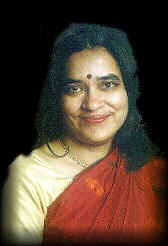 Interview
by Raj Ayyar Interview
by Raj Ayyar
I called Ruth Vanita on a lazy winter
afternoon about a month ago. I had just finished reading
Same-Sex Love in India, a book that she
co-authored with Saleem Kidwai. Our conversation was less of
an interview and more of a cozy, timeless cosmic chat of the
kind that's called 'adda' in Bengali, which covers
everything from cabbages to kings and spans centuries.
Since she used to teach at an elite
women's college attached to Delhi University, a college that
was a sister college to my own alma mater St. Stephen's, we
discovered many common acquaintances and friends. I felt
transported back in time to the courtyard of the Delhi
University coffeehouse where, in the comforting shade of an
ancient banyan tree, I would engage in passionate political,
literary, and philosophical discussions with teachers and
fellow students.
For me, as for many other South Asians,
the book is a real eye-opener. Same-Sex Love in India
cracks open the clichéd stereotype, held in both India and
the West that sees homoeroticism as a foreign import and
that India has always gone back and forth between arranged
heterosexual marriages and ascetic celibacy.
This stereotype has fueled the
pseudo-postcolonial argument that homosexuality is a
decadent Western colonial imposition that is alien to Indian
ways. On the other hand, it has also encouraged a
patronizing 'let's teach you about Stonewall' attitude on
the part of those Western gay activists who see Indian
gayness as a fragile, recent shoot that needs to be watered
by the springs of post-Stonewall gay lib.
On the contrary, Vanita and Kidwai show
that same-sex relationships have been affirmed and
celebrated in poetry and prose, in mythology, literature and
medical treatises throughout the lengthy span of Indian
history.
For instance, the book explores the
concept of 'swayamvara sakhi', a word found in the 11th
century story cycle the Kathasaritsagara that refers to deep
love between women and also refers to a self-chosen
relationship. This concept forms part of the basis of Ruth's
own marriage to her partner Mona Bachman.
Back to top
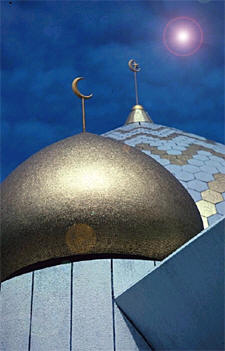 Her gay marriage comes, not out of recent developments in
Vermont law, let's say, but from venerable roots that go
deep in Hindu traditions not often publicized, that endorse
and even sanctify same-sex relationships and unions between
men and between women. The book delves into stories of sages
'born of two wombs', and of goddesses and gods that give
birth without a cross-sex partner. The book enabled me to
discover and re-discover ancient, medieval, modern, and
post-modern homoerotic Indian texts, Hindu, Buddhist, Jain,
Islamic, and Indian Christian texts that have been
suppressed, sanitized or minimized in mainstream Indian
history.
Her gay marriage comes, not out of recent developments in
Vermont law, let's say, but from venerable roots that go
deep in Hindu traditions not often publicized, that endorse
and even sanctify same-sex relationships and unions between
men and between women. The book delves into stories of sages
'born of two wombs', and of goddesses and gods that give
birth without a cross-sex partner. The book enabled me to
discover and re-discover ancient, medieval, modern, and
post-modern homoerotic Indian texts, Hindu, Buddhist, Jain,
Islamic, and Indian Christian texts that have been
suppressed, sanitized or minimized in mainstream Indian
history.
How many Hindus, for example, acknowledge
that the god Harihara/Ayyappa was the son of two of the
major deities of the Hindu pantheon, Vishnu and Shiva, the
former in drag, the latter pursuing 'her', "as a lordly
elephant would a she-elephant"? (p.71), or that one of
Shiva's sons (Skandha: literally 'jet of sperm') was born
after a convoluted process that involved the fire god Agni
swallowing the mighty Shiva's semen, which was literally too
hot for him?! (p.79).
Many Indians and Westerners, accustomed to
a very straight interpretation of the Krishna-Arjuna
relationship in the Bhagavad-Gita (that
influenced Max Muller and Thoreau so profoundly), would be
shocked to discover Arjuna aroused by Krishna's beautiful
waist, his penis visible through his yellow garments, "lips
red like the bimba fruit" and his "knees like a good tree,
rounded, and not too far apart" and who as 'Arjuni' has wild
sex with Krishna (pp. 92-93).
Saleem Kidwai, who has done a masterly job
of reclaiming homoerotic themes and texts in Indian Islam,
edits the medieval Islamic part of the work. Despite the
repressive homophobic provisions of sharia law with its
heavy-duty anti-sodomy penalties, there has been a
long-standing tradition of homoerotic celebration in Islam,
particularly in the Sufi tradition.
Also, as Kidwai stresses, even orthodox
Islam is not without its quota of same-sex love references.
For instance, the Koran promises beautiful boys and houris
to the faithful in Heaven (p.111). The ultra-conservative
hadith (sayings attributed to the prophet Mohammed) claims
that Mohammed saw God as a beautiful youth with "long hair
and cap awry." Same-Sex Love in India is a
slap in the face of 'compulsory heterosexuality', whether it
comes from the Left or the Right. It is a powerful challenge
to the fundamentalist re-writing of history, whether Hindu,
Muslim or Christian.
 Interviewer Raj Ayyar
Interviewer Raj Ayyar
|
Saleem
Kidwai is a medieval historian who taught at Ramjas
College, Delhi University for 20 years. He is working on
multiple projects now: homoerotic subtexts in Hindi
cinema, a biography of singer Begum Akhtar and many
others. Ruth Vanita, formerly an Associate professor at
Delhi University is now Associate Professor at the
University of Montana.
|
I remembered the varied intensities of
conversation and relating that I shared with men and women
in the shade of that banyan tree. The tenderness, the
respect and the long hours of just being-with . . . Back to
the banyan tree and the courtyard with Ruth Vanita.

Raj Ayyar:
Ruth, it's wonderful connecting
with someone who shares memories of Delhi University in the
70s with me. What brought you to the University of Montana?
Ruth Vanita:
Well, I applied to a whole bunch of
places and landed this job.
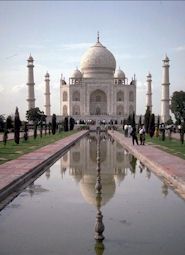 Technically,
I'm with the Liberal Studies program, which is a broad-based
multi-disciplinary program. I teach a lot of Literature
courses and bring in Women's Studies and Gender Theory
perspectives. I taught a course on Oscar Wilde, and am
planning to teach a comparative course on 'same-sex love in
Indian and British Literature.' Technically,
I'm with the Liberal Studies program, which is a broad-based
multi-disciplinary program. I teach a lot of Literature
courses and bring in Women's Studies and Gender Theory
perspectives. I taught a course on Oscar Wilde, and am
planning to teach a comparative course on 'same-sex love in
Indian and British Literature.'
Back to top
Raj Ayyar:
You were an Associate
Professor in the British Literature Department at Delhi
University, were you not?
Ruth Vanita:
That's right. I do want
to say that my courses here have been very well received.
Missoula is a liberal pocket of Montana. Many of the
students are from rural and working class backgrounds. I
think it makes many of them humble and willing to learn.
Raj Ayyar:
As opposed to,
let's say, someone from an Ivy League college here, or from
St. Stephen's, Miranda House, or some other elitist
institution in India?
Ruth Vanita:
Yes. My students at UM
don't have that know-it-all attitude.
Raj Ayyar:
It's refreshing to find my
negative stereotypes about places like Montana challenged!
(laughs). The University of Montana did give you a grant for
'same-sex love'?
Ruth Vanita:
Yes, I did get a
grant from UM to work on the book. We also got donations
from friends in India, both money and space to write the
book. We ended up hiring and paying for research assistants
out of our own pockets.
Raj Ayyar:
When you were working on the
book at the Delhi University, was there any homophobic
resistance to the project from the administration? What
about colleagues and students? I seem to remember that there
was a good deal of homophobia at DU in the 70s. It wasn't a
'bashing' homophobia, but a 'tolerant' one that winked at
same-sex relationships, provided one was discreet and 'grew
out' of them into a heterosexual marriage.
Ruth Vanita:
I wouldn't say
that there was an active homophobic resistance, as much as a
taken-for-granted heterosexism, where alternatives to hetero
married normswere not even perceived or given any reality
status. But the administration did not object to the
publication of the book. Permission was granted smilingly.
In fact, I presented papers on same-sex
love in Shakespeare's As You Like It at
seminars held at Delhi University, papers that were very
well-received by my straight colleagues. I don't know quite
how to explain this, other than to say that the liberalism
of a certain kind of academic Indian intellectual is truly
remarkable. Of course, both at DU and here in Montana, I
refrain from any personal disclosures in class. I don't see
personal disclosure as appropriate in the classroom. But,
that does not keep me from a full and free discussion of gay
themes, when a specific text or author demands it, e.g.
Shakespeare, Oscar Wilde or E.M. Forster.
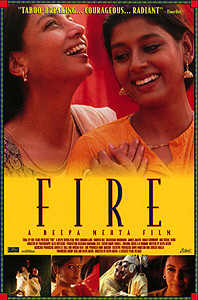
Raj Ayyar:
Same-Sex
Love opened my eyes to so much that's been repressed
or sanitized in mainstream India.
Ruth Vanita: The
repression and sanitization are not just problems with the
Indian political and religious Right. For example, Leftists,
liberals, and right-wingers joined hands in publicly
attacking the controversial lesbian art film Fire
when it was released in India.
Raj Ayyar:
So, there's a
paradoxical homophobic meeting ground between some elements
of the Left and some elements of the Right?
Ruth
Vanita: Yes. And
there is a common bias against any kind of sex discourse in
India, not just same-sex discourse. The language of
condemnation might vary, depending on who's making a
statement. Thus, a Hindu Rightist might use the language of
'homosexuality was never a part of our glorious tradition'
while someone from the Left might say 'it's a decadent
capitalist/colonial phenomenon' but both are homophobic and
sex-phobic. Puritanism and homophobia were certainly a part
of the Victorian British colonial tradition in India and
elsewhere. But, you can't lay all the blame at colonialism's
door.
Back to top
Raj Ayyar:
It's strange that in
countries like India or Robert Mugabe's Zimbabwe, many
so-called 'post-colonialists' invoke sodomy laws that were
put in place by British colonialism! It's also strange that
these laws have been largely repealed in many Western
colonial nations including the U.K., but still flourish in
their ex-colonies to the drumbeat of 'post-colonial'
identity.
Ruth Vanita:
Absolutely. It's
self-contradictory.
Raj Ayyar:
You know, one thing that
struck me about Same-Sex Love is that although
you and Saleem are sympathetic to 'constructivism', in that
you quote Foucault and Halperin, you seem to resist at least
one interpretation of Foucault: that the word 'homosexual'
was a construct that did not emerge till the medical
discourses of the 19th century, and that 'homosexuality'
became a medicalized identity in the 19th century and
thereafter.
Ruth Vanita:
Of course, the word 'homosexual' was not used
before the 19th century. I agree with Foucault there.
However, other words for same-sex love have been around
since the beginning of documented written history. Another
interesting point: there are Hindu medical texts that date
back to the medieval period, e.g. the Charaka Samhita and
the Sushruta Samhita that do categorize and medicalize
same-sex desire.
Raj Ayyar:
That means the medicalization goes back centuries
before the 19th century texts that caught Foucault's eye?
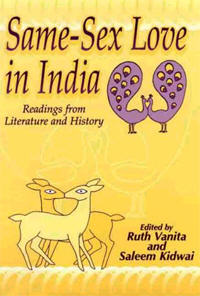 Ruth Vanita: Yes.
And, even in the West, medical and other categorizations
were known since at least the 10th century. Words like 'tribade',
'sapphist' etc. were in use long before 'lesbian' or
'homosexual'.
Ruth Vanita: Yes.
And, even in the West, medical and other categorizations
were known since at least the 10th century. Words like 'tribade',
'sapphist' etc. were in use long before 'lesbian' or
'homosexual'.
Raj Ayyar:
Tell us a little
about your involvement with the pioneering Indian feminist
journal Manushi. Were you the co-founder?
Ruth Vanita:
Yes. Madhu Kishwar and I co-founded Manushi
way back in 1978. It came out of a women's group that used
to meet in my dorm room at Miranda House, DU, during my
student years. The group developed the concept of the
magazine.
Raj Ayyar:
I notice that many straight Indian women who
identify with feminist causes have a great respect for
Manushi.
Ruth Vanita:
Yes, well, the journal
was never explicit about lesbian issues. It addressed gender
oppression without getting too explicit about sexual
orientation. This was typical of the Indian women's movement
in the 70s, which carefully refrained from any discussion of
sexuality and sexual issues and focused almost exclusively
on violence against women------spousal abuse, dowry deaths
etc. I think that tendency is changing now. A lot of younger
Indian feminists are starting to explore other issues,
including lesbian issues. There were many lesbians within
the Indian women's movement even in the 70s, but we never
discussed our sexuality openly.
Back to top
Raj Ayyar:
I remember that there were many young gay Indian
males in the 70s who, likewise, never addressed or discussed
their sexuality openly. So, there was no support system, no
forum for airing gay-political ideas and certainly no
political base.
Ruth Vanita:
You know, this is part of that phobia of
sex-discourse that we discussed earlier. But it's not
even-handed. After all, there is a lot of talk about
heterosexual marriage in India and this IS a way of talking
about sex, at least about heterosexuality.
Raj Ayyar:
But, isn't this another
sanitized way of talking about heterosexuality.... minus the
sex? And, when we consider those passionate Indian same-sex
relationships, be it 'sakhyani', 'dosti' or 'yaari', once
again these relationships are socially approved because they
are considered non-sexual. Yet, in your book you point out
that many such 'friendships' are strongly charged with the
erotic and the romantic, even if there's no sexual 'acting
out'.
Ruth Vanita:
I think it's
important to remember that Indian cultures place a
tremendous value on friendship, in a way that has been
largely forgotten in the West and certainly in America. In
India, because everyone (till recently) was so oblivious of
homosexuality, it was considered perfectly normal for a
same-sex friend to come over to your house, hold hands, hug,
and even sleep in your bed. That would be unthinkable in
contemporary America!
Raj Ayyar:
Some of that is due to the very deep-seated
homophobia in the U.S. It was not that uncommon in 19th
century America, Whitman's America. But there is such
self-consciousness about sexual identity in the U.S. today
that all same-sex closeness is seen as suspect. Deep
emotional bonding has all but disappeared even in
heterosexual discourses and practices.
Ruth Vanita:
Some of it is due
to the rushed quality of life here. Most Americans meet to
'do' something together, seldom to just be together. And
these deep bonds need patience, a lot of time, and a lot of
just 'hanging out' together for no particular reason. On the
other hand, some American women both gay and straight seem
to find it easier to develop emotional closeness, than many
American men do.
Raj Ayyar:
Could you tell us a little your book Sappho
and the Virgin Mary?
Ruth Vanita:
Well, I argue that even in the straight white
male patriarchal tradition, the Creatrix has always
influenced the literary imagination. The Romantics,
Meredith, Forster etc. were deeply influenced by her.

Raj Ayyar:
Is this Virgin
Mary cult a backdoor resurgence of the Goddess archetype in
the patriarchal West?
Ruth Vanita:
Absolutely. There's been a
lot of research on this theme. Not only the Virgin but
Catholic female saints in the Middle Ages can be seen as the
re-writing of goddesses such as Demeter, Persephone, Isis
and so on. However, my book focuses not on the medieval
period but on the modern period from the Renaissance
onwards.
Raj
Ayyar: Don't you
think that Protestantism can be seen as a desperate attempt
to stamp out the feminine in Christianity?
Ruth Vanita:
In a sense, yes. You can
see this trend as early as Martin Luther's attempt to purge
the church of Mary and all female icons. I don't think that
the female presence has disappeared from Protestantism,
however.
Back to top
Raj Ayyar:
What about the connection between Sappho and the
Virgin?
Ruth Vanita:
Sappho has been
regarded as the ultimate female lyric writer, whose style
was a model for many writers, including the Romantic
Movement. Her lesbianism was a hovering presence surrounding
this influence. I've reproduced paintings in the book that
show the Virgin surrounded by female saints and feminized
males, be they angels or saints. She is a mentor, guardian
and teacher to them. Sappho too was surrounded by young
female protégées; she played teacher and mentor to
them...two different ways of approaching the same thing. Of
course, Sappho represents the more sexualized form, while
the Virgin clearly does not. And yet, convents and nunneries
were refuges for same-sex communities. Hostile Victorian
puritans, wherein the connection between the two was stated
in a negative manner, saw them as “hotbeds of Sapphism”.
Raj Ayyar:
In Same-Sex Love, you argue against
the view that gender-segregated monastic communities were
always oppressive to women. You point out wryly that the
privileging of procreative sex is not necessarily of
advantage to women.
Ruth Vanita:
Uh-huh. I think it's
healthy to have alternatives to procreative sex and
heterosexual marriage. I'm not denying that some women were
oppressed in these monastic communities, but in many cases
it was based on a free choice. You see that clearly in the
writings of some Buddhist nuns as also in the writings of
some women in the West like Hildegard of Bingen. For these
women, it is obvious that the monastic lifestyle was an
active, autonomous choice.
Raj Ayyar:
Do you think that the Western
'coming out' model applies to all cultures? Ever since
Stonewall in the late 60s, many Western gay activists have a
fixed model of the coming-out process in their heads, and
speak and act as if it's the sole paradigm for lesbians and
gay men everywhere.
Ruth Vanita:
Well, I don't think you can make a blanket
recommendation for India, given the great diversity of
cultures there. However, I do think that the gay person has
to make some kind of statement in saying 'no' to the
standard arranged heterosexual marriage, whether you frame
that as 'coming out' or not.
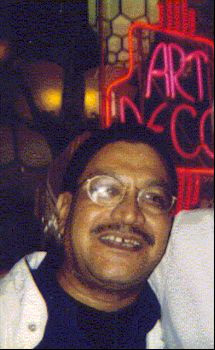 Ashok Kavi
Ashok Kavi
|
Raj Ayyar:
What do you
think of Ashok Kavi? As you know, there are many gay
movements popping up all over the Indian urban scene,
thanks to the pioneering efforts of Ashok and a few
others.
Ruth Vanita:
I respect Ashok greatly. In fact, when he
came out in a popular Indian magazine many years ago, I
thought 'great!' I grew up with many of the classic gay
feelings of loneliness, feeling different from others,
cut-offness and so on. Ashok's openness has encouraged
many gay Indians to come to terms with their sexuality.
|
Raj Ayyar:
Ruth, it's been a joy talking with you.
Ruth Vanita:
Likewise, Raj. I've enjoyed our
conversation.
Back to top
|